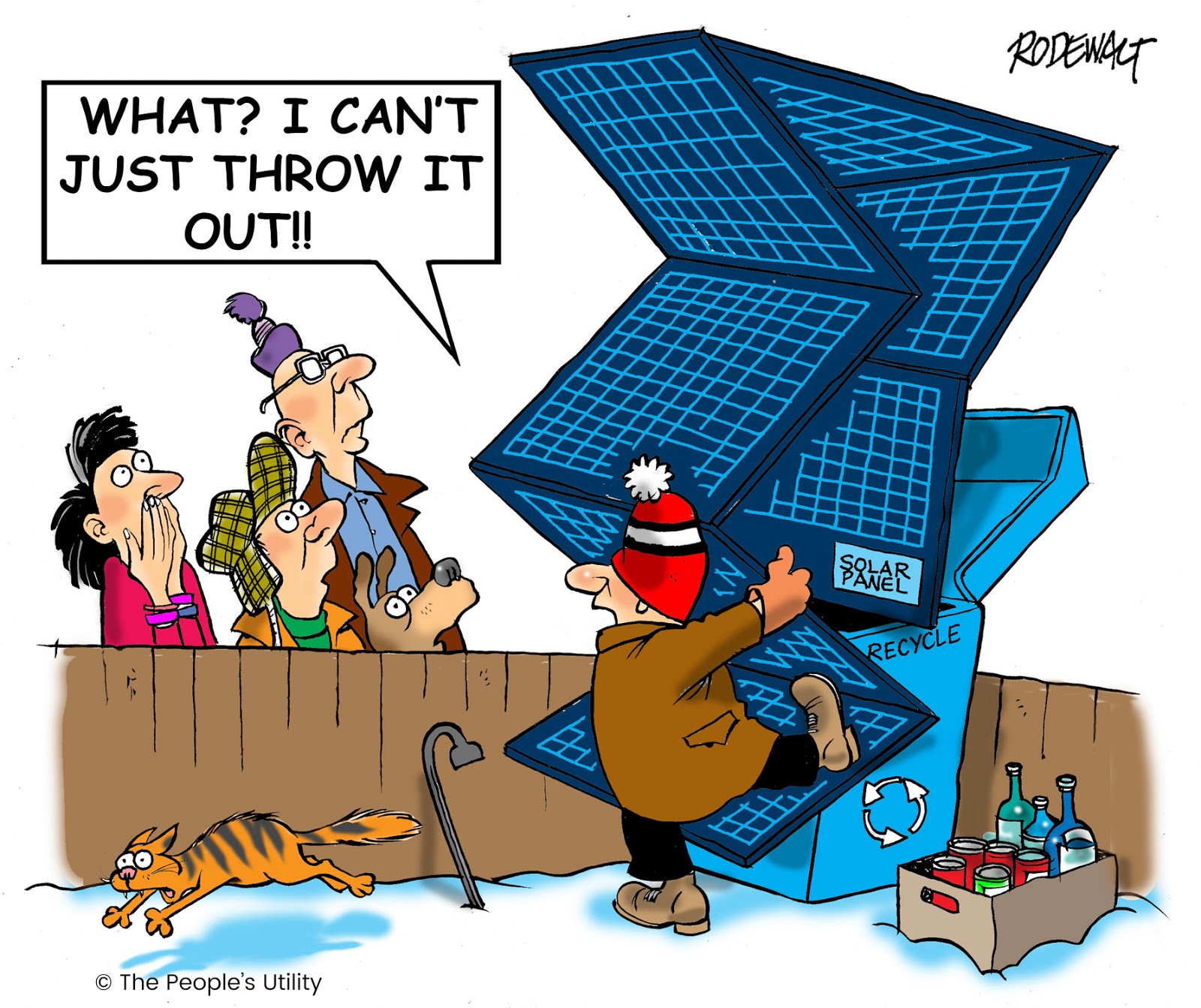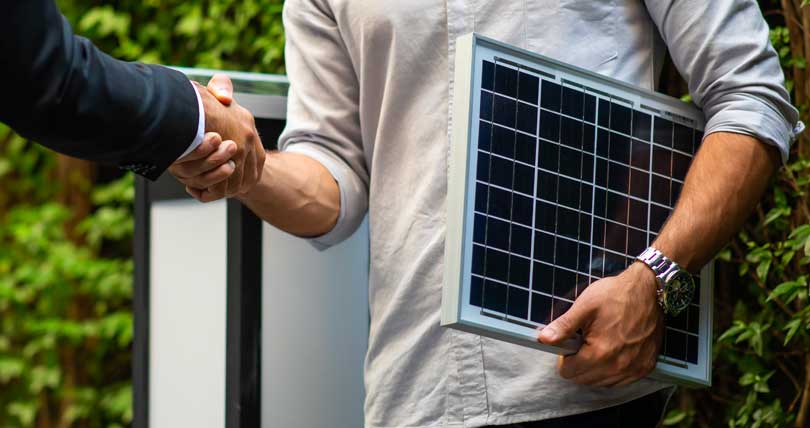“Alberta is taking a shine to solar power”, says Shannon Phillips, Environment Minister of Alberta. It is a hot button issue. As more people begin to adopt renewable technologies, questions about the future impact that PV Solar will have on the environment are bound to be on Albertans’ minds. We asked Stewart McGrenary of PLUNC, one of the most trusted recyclers in Europe, to provide us with his perspectives on Alberta’s renewable energy market and the future of solar panel recycling.
Here in our local market, Green Alberta Energy has always provided financial support to Micro Generators who have invested in PV Solar. And, as we move into 2019 the Light up Alberta program will be dramatically enhanced. The new program should attract the attention of everyone who has, or ever has considered adding solar to their rooftop. Check back with us in a few weeks for more information. This is a private sector initiative (zero government subsidies) that we are going to implement in an attempt to help Micro Generators become 100% Green. Stay tuned.
Nick Clark, Director, Green Alberta Energy, a division of Utility Network and Partners Inc.
Solar Panels: Recycling and Disposal
By: Stewart McGrenary, Managing Director of Plunc.com
As our energy demands continue to rise, governments around the globe continue to move towards adding more renewable energy generation to the grid to meet emissions targets.
As these changes are being made at higher levels, everyday consumers are bound to want to do their part for the environment and save money on their utilities. Since it isn’t practical for everyone to have wind farms or hydroelectric plants in their home, it is no doubt an increase in the adoption of solar technology is coming.
Solar panels continue to rise in popularity due to their ease of installation, low maintenance and high return on investment. Alberta’s solar industry alone has grown by nearly 500% since 2015. The rapid growth of Alberta’s solar sector has meant that about 3,100 solar installations have been completed, and installed solar capacity has increased from 6 MW in 2015 to 35 MW in 2018.
This is positive news for the solar sector in Alberta, however, solar technology contains a range of toxic materials which need to be recycled at the end of their life cycle.
Unfortunately, few companies have the right process for doing this, which means this could create a global problem in the decades to come.
Top 3 myths of solar panel installation
Over time, many myths have developed around solar panels. Unfortunately, these may have caused some people to be put off investing in a system for their energy needs. Below are the top 3 myths.
Myth #1: Solar panels are expensive
Due to economies of scale, and increasing popularity, the cost of solar panels has actually gone down year-on-year. Although it varies from place to place, it is normal to see a return on your investment within 5-10 years. A piece by the New York Times uses data to reach the conclusion that solar panels can significantly increase the resale value of a property.
Moreover, more governments are waking up and offering incentives for installing a system. For instance, Canada offers tax credits per installation. Over the last few years, the Government of Alberta has introduced a number of solar rebate programs. The programs were such a success the province announced recently that it would increase the rebates available both for homeowners and non-profits.
In August, Green Alberta Energy spoke to a number of solar industry experts and according to Gordon Howell, a solar pioneer in the province, solar is “the cheapest-cost electricity option for homeowners even without the Alberta government incentive.”
Myth #2: Solar panels last forever
Like with any electrical component, performance drops over time. A well-maintained solar panel will lose roughly a percentage of production every 10 years. As a result, they will need to be replaced eventually. That is where the issue of recycling comes into play.
Solar panels contain toxic chemicals and glass which need to be broken down in a specialised recycling process. We will delve into this later.
Myth #3: Solar energy can’t work on a mass scale
Contrary to popular belief, solar panels can work in almost any climate. China continues to increase the rate of production and spends billions of dollars building solar farms the size of small cities.
Alberta has some of the best access to sunshine in Canada, in part because of its open, blue sky. In fact, Calgary has a greater solar resource potential than Rio De Janeiro, Brazil (by 39 kWh).
As compared to other forms of renewable energy, solar panels are cheap and easy to maintain. Moreover, they can be made portable.
Interestingly, the earth receives enough sunlight each hour to meet the world’s annual energy consumption needs. The advantages of solar panels mean that they are likely to play a big role in the earth’s sustainability. I would hypothesise that 20 years from now owning a home without a solar panel would become as unusual as not having a phone.
The importance of recycling solar panels
Before we delve into the importance of recycling solar panels, it is worth taking a look at what they are made of:
- Glass (for the front cover)
- Aluminium (This is used to encase the solar panel and ensure longevity)
- Synthetic materials such as PVA, EVA and fluoride are used to ‘lock in’ the cells
- Lead, copper, gallium and other metals
- Silicon solar cells
The International Renewable Energy Agency (IRENA) in 2016 estimated there was about 250,000 metric tonnes of solar panel waste in the world at the end of that year. IRENA projected that this amount could reach 78 million metric tonnes by 2050.
Additionally, sourcing materials to make glass degrades land and uses huge amounts of energy. Moreover, it increases surface runoff, thereby increasing the likelihood of flooding. Fortunately, glass is 100% recyclable. It takes much less energy to recycle glass than to make it from scratch.
Metals such as aluminium, lead, and copper take large amounts of energy to mine. Synthetic materials such as PVA, EVA and fluoride sit in landfills, seep into the soil and eventually make waterways unsafe.
Although solar panel recycling facilities are not commonplace in the market today, solar panel recycling is likely to become a booming industry in the near future. When there is demand for a service, competitive markets are bound to fill the void with companies willing to provide that service.
A 2016 study on solar panel recycling by IRENA found that in the long term, building dedicated PV panel recycling plants makes economic sense. It estimated that recovered materials could be worth $450 million by 2030 and exceed $15 billion by 2050.
In fact, Europe’s first dedicated solar panel recycling plant recently opened in France in 2018, and the company says it is aiming to build more as thousands of tonns of aging solar panels are set to reach the end of their life in coming years.
Not only can panels be recycled, but they can also be repurposed. EnergyBin, a members-only business to business web platform allows for solar companies to list or seek solar components for sale or resale.
While its sole purpose isn’t resale, EnergyBin has found success in connecting sellers with buyers interested in purchasing replacement components for solar arrays. Installers seeking older replacement panels to make the panels in existing solar arrays might be hard-pressed to find them with distributors. Those years-old components might be listed on EnergyBin.
Additionally, when a panel reaches its warranty lifespan, that doesn’t necessarily mean it can’t produce energy. One organization (WFTSS) is installing used panels on volunteer projects where any amount of energy helps.
Since its start, WFTSS has kept more than 100 tons of solar materials from landfills. Its repurposed panels have been used to create solar and storage microgrids for people in need.
How are solar panels recycled?
Up until recently, aging or broken solar panels have typically been recycled in general-purpose glass recycling facilities, where only their glass and aluminium frames are recovered and their specialty glass is mixed in with other glass. The remainder is often burned in cement ovens.
Not only is the dollar value of the recovered materials notable, but adding solar panel recycling facilities will increase the number of jobs and entrepreneurial opportunities available. Therefore, it is in our economic and environmental interests that solar panels are recycled effectively.
As previously mentioned, solar panels contain many different components which must be broken down. This requires a specialised recycling process:
- The aluminium strips and cables are removed.
- The solar panel is cut and crushed.
- In order to remove the semiconductor films, sulphuric acid and hydrogen peroxide are added to a drum and slowly churned for 5-6 hours
- The EVA covered glass is separated out.
- The glass is then moved onto a vibrating screen. This helps to remove the EVA which is collected by a conveyor. The glass is washed clean and ready for recycling.
- The metals are separated using sodium hydroxide. They can then be collected and used to make new solar panels.
The above process ensures that about 92% of the solar panel is recycled.
Final thoughts
Canada is a trailblazer with regard to renewable energy production. However, more can be done with regard to increasing the effectiveness of recycling solar panels.
For solar power to become a leading renewable energy source, we need to think about what happens at the end of a solar panel’s lifecycle. Landfills aren’t the answer. A balance between how we use ‘clean’ energy sources and how we handle their decommissioning and recycling in the future can make a big difference to the world’s economy and sustainability.
———
This article was written in collaboration with Plunc one of the most trusted online recyclers in Europe. Plunc is one of the most competitively priced in the market when it comes to reimbursing for high end electronics.




